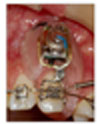Abstract
Objective
The purpose of this study was to determine whether an exogenous electric current to the alveolar bone surrounding a tooth being orthodontically treated can enhance tooth movement in human and to verify the effect of electric currents on tooth movement in a clinical aspect.
Methods
This study was performed on 7 female orthodontic patients. The electric appliance was set in the maxilla to provide a direct electric current of 20 µA. The maxillary canine on one side was assigned as the experimental side, and the other as control. The experimental canine was provided with orthodontic force and electric current. The control side was given orthodontic force only. Electrical current was applied to experimental canines for 5 hours a day. The amount of canine movement was measured with an electronic caliper every week.
Results
The amount of orthodontic tooth movement in the experimental side during 4 weeks was greater by 30% compared to that of the control side. The amount of increase in tooth movement in the experimental side was statistically significant. The amount of tooth movement in the experimental side during the first two weeks was greater than that in the following two weeks. The amount of weekly tooth movement in the control side was decreased gradually.
Figures and Tables
References
1. Baumrind S. A reconsideration of the propriety of the "pressure-tension" hypothesis. Am J Orthod. 1969. 55:12–22.

2. Mostafa YA, Weaks-Dybvig M, Osdoby P. Orchestration of tooth movement. Am J Orthod. 1983. 83:245–250.

3. Fukada E, Yasuda I. On the piezoelectricity effect of bone. J Physiol Soc Japan. 1957. 12:1158–1162.
4. Bassett CA, Becker RO. Generation of electrical potentials by bone in response to mechanical stress. Science. 1962. 137:1063–1064.

6. Brighton CT, Friedenberg ZB. Electrical stimulation and oxygen tension. Ann N Y Acad Sci. 1974. 238:314–320.

7. Lavine LS, Shamos MH, Moss ML. The influence of electric current on bone regeneration in vivo. Acta Orthop Scand. 1971. 42:305–314.

8. Jorgensen TE. The effect of electric current on the healing time of crural fractures. Acta Orthop Scand. 1972. 43:421–437.

9. Masureik C, Ericksson C. Preliminary clinical evaluation of the effect of small electrical currents on the healing of jaw fractures. Clin Orthop Relat Res. 1977. 124:84–91.

10. Brighton CT, Friedenberg ZB, Mitchell EI, Booth RE. Treatment of nonunion with constant direct current. Clin Orthop Relat Res. 1977. 124:106–123.

11. Cochran GV, Pawluk RJ, Bassett CA. Stress generated electric potentials in the mandible and teeth. Arch Oral Biol. 1967. 12:917–920.

12. Zengo AN, Pawluk RJ, Bassett CA. Stress-induced bioelectric potentials in the dentoalveolar complex. Am J Orthod. 1973. 64:17–27.

13. Zengo AN, Bassett CA, Pawluk RJ, Prountzos G. In vivo bioelectric potentials in the dentoalveolar complex. Am J Orthod. 1974. 66:130–139.

14. Kubota K, Yoshimura N, Yokota M, Fitzsimmons RJ, Wikesjö ME. Overview of effects of electrical stimulation on osteogenesis and alveolar bone. J Periodontol. 1995. 66:2–6.

15. Jacobs JD, Norton LA. Electrical stimulation of osteogenesis in pathological osseous defects. J Periodontol. 1976. 47:311–319.

16. Gerling JA, Sinclair PM, Roa RL. The effect of pulsating electromagnetic fields on condylar growth in guinea pigs. Am J Orthod. 1985. 87:211–223.

17. Narkhede PR. A histologic evaluation of the effect of electrical stimulation on osteogenic changes following placement of blade-vent implants in the mandible of rabbits. J Oral Implantol. 1998. 24:185–195.

18. Davidovitch Z, Finkelson MD, Steigman S, Shanfeld JL, Montgomery PC, Korostoff E. Electric currents, bone remodeling, and orthodontic tooth movement: I. The effect of electric currents on periodontal cyclic nucleotides. Am J Orthod. 1980. 77:14–32.
19. Davidovitch Z, Finkelson MD, Steigman S, Shanfeld JL, Montgomery PC, Korostoff E. Electric currents, bone remodeling, and orthodontic tooth movement: II. Increase in rate of tooth movement and periodontal cyclic nucleotide levels by combined force and electric current. Am J Orthod. 1980. 77:33–47.
20. Davidovitch Z, Steigman S, Finkelson MD, Yost RW, Montgomery PC, Shanfeld JL, et al. Immunohistochemical evidence that electric currents increase periosteal cell cyclic nucleotide levels in feline alveolar bone in vivo. Arch Oral Biol. 1980. 25:321–327.

21. Davidovitch Z, Korostoff E, Finkelson MD, Yost RW, Montgomery PC, Steigman S, et al. Effect of electric currents on gingival cyclic nucleotides in vivo. J Periodontal Res. 1980. 15:353–362.

22. Hashimoto H. Effect of micro-pulsed electricity on experimental tooth movement. Nippon Kyosei Shika Gakkai Zasshi. 1990. 49:352–361.
23. Park SJ, Lee YJ, Park YG. A study on the efects of electrical stimulation by the miniature electric device on the tooth movement and tissue remodeling. Korea J Orthod. 2003. 33:279–291.
24. Shamos MH, Lavine LS. Piezoelectricity as a fundamental property of biological tissues. Nature. 1967. 213:267–269.

25. Braden M, Bairstow AG, Beider I, Ritter BG. Electrical and piezoelectrical properties of dental hard tissues. Nature. 1966. 212:1565–1566.

26. Marino A, Gross BD. Piezoelectricity in cementum, dentin and bone. Archs Oral Biol. 1989. 34:507–509.
27. Davidovitch Z, Shanfield JL. Cyclic AMP levels in alveolar bone of orthodontically-treated cats. Archs Oral Biol. 1975. 20:567–574.

28. Norton LA, Rodan GA, Bourret LA. Epiphyseal cartilage cAMP changes produced by electrical and mechanical pertubations. Clin Orthop Relat Res. 1977. 124:59–68.
29. Spadaro JA. Electrically stimulated bone growth in animals and man. Review of the literature. Clin Orthop Relat Res. 1977. 122:325–332.
30. Beeson DC, Johnston LE, Wisotzky J. Effect of constant currents on orthodontic tooth movement in the cat. J Dent Res. 1975. 54:251–254.
31. Stark TM, Sinclair PM. Effect of pulsed electromagnetic fields on orthodontic tooth movement. Am J Orthod Dentofacial Orthop. 1987. 91:91–104.





 PDF
PDF ePub
ePub Citation
Citation Print
Print










 XML Download
XML Download